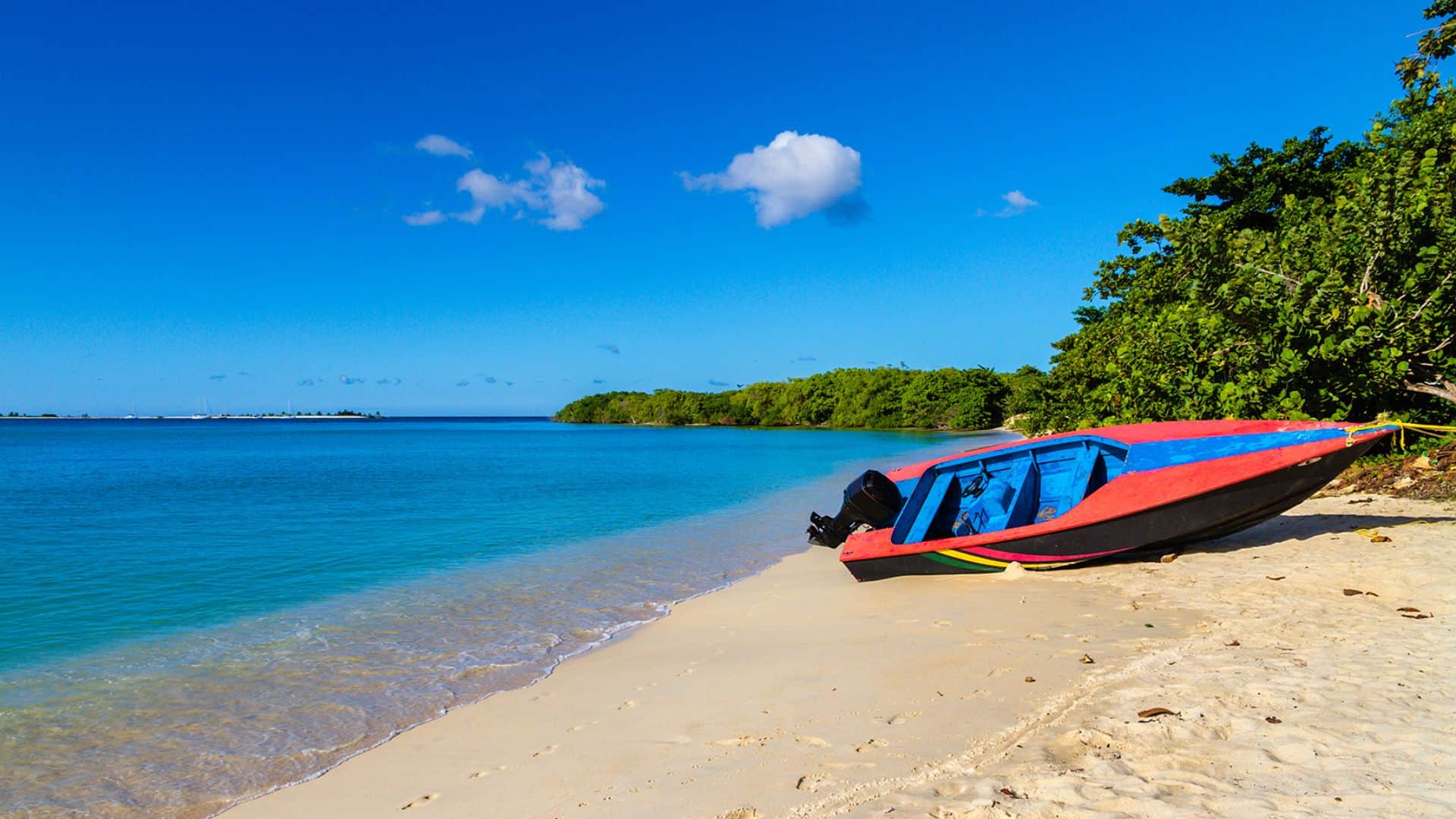Weather
Year round warm weather and sunshine make Grenada a great destination at any time of the year, Like most Caribbean Islands, Grenada’s summer like climate experiences few variations. The seasons are expressed not by winter and summer but by rainy season and dry season.
Grenada is covered in lush tropical vegetation and rainforests. The average year round temperature is 80 degrees Fahrenheit. Daily highs are usually around 86 and nightly lows around 75. The hottest months are from June to August, the coolest November to February. Northeast trade winds provide cool comfortable relief from the more humid weather during the summer, so if you travel during the summer you shouldn’t be overwhelmed by the tropical heat.
Grenada’s seasons are measured by rainfall rather than by temperature. The dry season falls between January and May, when showers are few and sporadic. The rainy season is June through December, when conditions are more humid and Grenada experiences some heavy rainfall, but usually the showers do not last very long.
Weather in Grenada varies according to altitude. The island has very remarkable topography, with some very mountainous areas. Around the coastline weather tends to be more hot and humid, but as you travel toward the interior of the island, temperatures change drastically. The rain forests of Grenada are often shrouded in thick mists, and temperatures in the forests are considerably cooler than on the outer edges of the island. No matter what the season, light rains often fall in the mountainous and forested areas of Grenada.

Population
Grenada’s population numbers about 93,000, comprising citizens of African, East Indian, and European descent. The largest proportion of the population, about 75%, is of African descent.
0-14 years: 33.9% (male 15,329/female 14,997)
15-64 years: 62.7% (male 29,711/female 26,436)
65 years and over: 3.4% (male 1,431/female 1,598) (2005 est.)
Government
The tri-island state remains within the British Commonwealth as an independent nation and the Governor General represents Her Majesty the Queen. There is a 13-member Senate and a House of Representatives with a Speaker and fifteen members are each representing a constituency.

Currency
The East Caribbean dollar is the currency used locally. It is linked to the US dollar.
At the banks you will get EC$2.67 for US$l cash and EC$2.68 for US$l travellers cheques. Shops will give EC$2.60. Currently (Dec 08) you will get about EC$4.2 to the £ Sterling.
Electricity
Voltage is 220 volts – 50 cycles. Appliances rated at 110 volts (US standard) normally work satisfactorily with a transformer.
Entry Requirements
A valid passport and return or onward ticket is required. However, proof of citizenship bearing a photograph is acceptable from British, Canadian and US citizens, if accompanied with a copy of your birth certificate. Visas are not required from citizens of USA, Canada, United Kingdom and its dependencies, British Commonwealth countries, Caribbean countries (except Cuba), European Community countries and their dependencies, Norway, Japan, and Israel. Commonwealth of Independent States such as Russia and the Ukraine and the Baltic States such as Estonia and Latvia, and other eastern European countries such as Hungary, Romania and Slovenia are required to purchase a tourist visa on arrival in Grenada and costs EC$ 25.
Duty Free Allowances – Personal items, one quart in total wines and spirits, half-pound tobacco or 50 cigars or 200 cigarettes. No restrictions on the amount of money that can be brought in. Restricted items are fruits, vegetables, meat, soil, illegal drugs, firearms and ammunition.
Medical Facilities
There is a General Hospital in St.George’s, a smaller hospital in Mirabeau on the east coast and one in Carriacou. A private small Hospital in St.Pauls. Clinics and doctors are available, and housecalls can be made.
Time Zone
Grenada, Carriacou & Petit Martinique are in the Atlantic Standard Time Zone, one hour ahead of Eastern Standard Time and four hours behind GMT.
Water
It is safe to drink the water here.

Geography
Grenada and its largely uninhabited outlying territories are the most southerly of the Windward Islands. The Grenadine Islands chain consists of some 600 islets; those south of the Martinique Channel belong to Grenada, while those north of the channel are part of the nation of St. Vincent and the Grenadines. Located about 160 kilometers north of Venezuela, at approximately 12° north latitude and 61° west longitude, Grenada and its territories occupy a total area of 433 square kilometers.
Grenada, known as the Spice Isle because of its production of nutmeg and mace, is the largest at 310 square kilometers. The island is oval in shape and framed by a jagged southern coastline; its maximum width is thirty-four kilometers, and its maximum length is nineteen kilometers. St. George’s, the capital and the nation’s most important harbour, is favorably situated near a lagoon on the southwestern coast. Of all the islands belonging to Grenada, only two are of consequence: Carriacou, with a population of a few thousand, and its neighbor Petit Martinique, roughly 40 kilometers northeast of Grenada and populated by some 700 inhabitants.
Part of the volcanic chain in the Lesser Antilles arc, Grenada is more rugged and densely foliated than its outlying possessions, but other geographical conditions are more similar. Grenada’s landmass rises from a narrow, coastal plain in a generally north-south trending axis of ridges and narrow valleys. Mount St. Catherine is the highest peak at 840 meters.
Although many of the rocks and soils are of volcanic origin, the volcanic cones dotting Grenada are long dormant. Some of the drainage features on Grenada remain from its volcanic past. There are a few crater lakes, the largest of which is Grand Etang. The swift upper reaches of rivers, which occasionally overflow and cause flooding and landslides, generally cut deeply into the conic slopes. By contrast, many of the water courses in the lowlands tend to be sluggish and meandering.
The abundance of water is primarily caused by the tropical, wet climate. Yearly precipitation, largely generated by the warm and moisture-laden northeasterly trade winds, varies from more than 350 centimeters on the windward mountainsides to less than 150 centimeters in the lowlands. The greatest monthly totals are recorded throughout Grenada from June through November, the months when tropical storms and hurricanes are most likely to occur. Rainfall is less pronounced from December through May, when the equatorial low-pressure system moves south. Similarly, the highest humidities, usually close to 80 percent, are recorded during the rainy months, and values from 68 to 78 percent are registered during the drier period. Temperatures averaging 29°C are constant throughout the year, however, with slightly higher readings in the lowlands. Nevertheless, diurnal ranges within a 24-hour period are appreciable: between 26°C and 32°C during the day and between 19°C and 24°C at night.
Grenada, being on the southern edge of the hurricane belt, has suffered only three hurricanes in fifty years. Hurricane Janet passed over Grenada on 23 September 1955 with winds of 115 mph, causing severe damage. The most recent storms to hit have been Hurricane Ivan on September 7th 2004 causing severe damage and thirty-nine deaths and Hurricane Emily on July 14th 2005, causing serious damage in Carriacou and in the north of Grenada which had been relatively lightly affected by hurricane Ivan.

 English
English 

